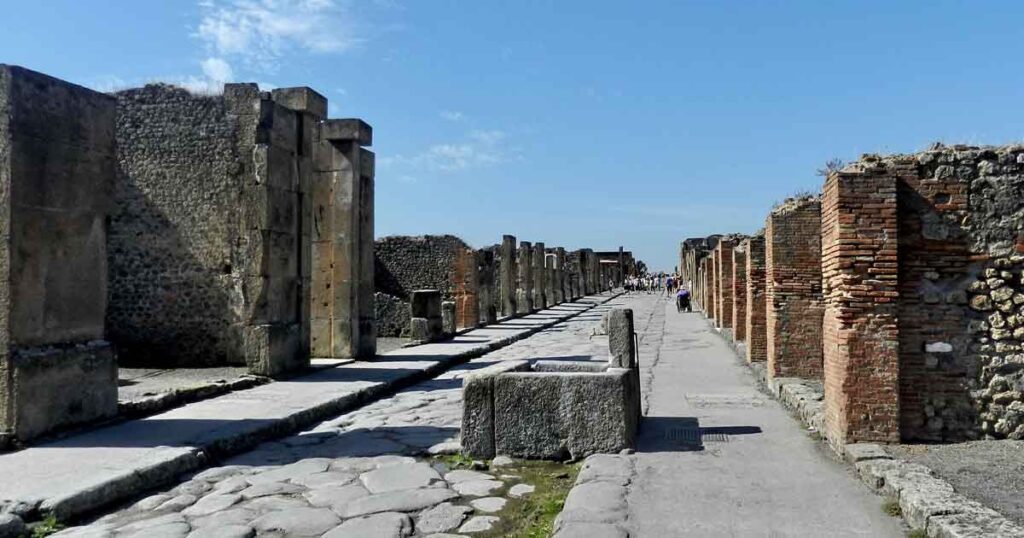
Recent excavations at Pompeii have confirmed what archaeologists long suspected but struggled to document: survivors of Mount Vesuvius’s catastrophic 79 AD eruption returned to live among the ruins. The Pompeii archaeological discovery, announced Wednesday by site directors, provides concrete evidence that people inhabited the devastated Roman city for centuries after the volcanic disaster that killed thousands.
Fire pits, cooking areas, and numerous pottery fragments spanning from the late 1st century AD through the 5th century AD were discovered. These findings confirm that both survivors who lacked resources to relocate and newcomers seeking valuable items lived in makeshift settlements within the ruined walls.
Gabriel Zuchtriegel, director of the Pompeii Archaeological Park, described the post-eruption community as “a precarious conglomerate, a kind of camp or favela among the still recognizable ruins.” According to the archaeological data, residents transformed the destroyed city into an informal settlement where people survived without typical Roman infrastructure including water systems, sewage networks, or organized trade.
“Thanks to the new excavations, the picture is now clearer: post-79 Pompeii reemerges, more than a city, a precarious and grey agglomeration,” Zuchtriegel explained.
The inhabitants repurposed damaged buildings, moving into upper floors of houses while converting buried ground levels into cellars equipped with ovens and mills. Ash-filled rooms became storage spaces, and people erected temporary structures amid toppled columns and cracked frescoes.
Archaeological material revealed that residents systematically searched collapsed rooms for jewelry, tools, and household objects, even risking encounters with decomposing bodies. The newcomers joined original residents who could not afford to establish new lives elsewhere, creating a community focused on salvaging what remained of the once-prosperous city.
Before the eruption, Pompeii housed approximately 20,000 people. Current estimates suggest 15 to 20 percent of the population perished when volcanic gases and ash engulfed the city. Since excavations began in 1748, archaeologists have identified roughly 1,300 victims across the 22-hectare site.
Historical records indicate that Emperor Titus dispatched two former consuls to supervise recovery operations following the disaster. However, these official efforts ultimately failed, and Pompeii never regained its former prosperity or population levels.
“Judging by the archaeological data, it must have been a conglomerate where people lived in precarious conditions and without the infrastructures and services typical of a Roman city,” stated the Archaeological Park in their announcement.
The settlement persisted until the 5th century AD, when final abandonment occurred following another volcanic event known as the Pollena eruption. Archaeological evidence shows makeshift habitation continued throughout this extended period despite the challenging conditions.
While signs of reoccupation had been detected in earlier excavations, these traces were often dismissed or destroyed during the rush to access Pompeii’s famous frescoes and intact structures. Zuchtriegel noted that “the faint traces of the site’s reoccupation were literally removed and often swept away without any documentation.”
“The momentous episode of the city’s destruction in 79 AD has monopolized the memory,” he explained, acknowledging that the dramatic story of the eruption overshadowed evidence of survival and adaptation.
The current excavations represent the first systematic documentation of post-eruption occupation, providing crucial insight into how communities responded to catastrophic destruction in the ancient world.
The discoveries draw striking parallels to modern situations, as more than three million people currently live in Mount Vesuvius’s shadow and face similar risks should another major eruption occur. Like their ancient counterparts, contemporary residents continue life despite awareness of the volcano’s destructive potential.
Pompeii remains Italy’s second most-visited tourist attraction after the Colosseum in Rome, welcoming 4.17 million visitors in 2024. The UNESCO World Heritage Site continues revealing new discoveries, with approximately one-third of the archaeological area still buried beneath volcanic ash.
The reoccupation findings join several significant discoveries made at Pompeii throughout 2024. In April, archaeologists uncovered life-sized statues of a man and woman in a tomb at the site. February brought the discovery of paintings depicting Dionysus, the Greek god of wine, painted on walls of a large banquet room. The previous month, excavations revealed a large private bathhouse containing multiple rooms and a plunge pool.
Header image: Main street in Pompeii (CC BY 3.0)


More Stories
7-Year-Old Maya Child Wore Jade “Tooth Gem” in Ancient Ritual Practice
Museum Employee Steals 3,000-Year-Old Egyptian Pharaoh’s Bracelet, Sells for $4,000
Spanish Researchers Create First Complete 3D Map of Historic La Pileta Cave Using Advanced LiDAR